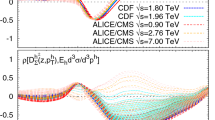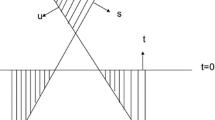Summary
As a continuation of previous work, we determine hadronic-production cross-sectionsσ n (s) satisfying exactly the high-energy empirical laws known for the first, second and third multiplicity moments. The result is obtained in the form of a second-order linear differential equation forσ n (s) which allows one to calculate explicitly all successive moments. In particular, the fourth moment is in excellent agreement with the data. The asymptotic solution of the equation forσ n (s) is given analytically. KNO scaling turns out to be an asymptotic property of our solution. The full solution forσ n (s) is studied numerically and the KNO plot is compared with the data. No free parameters are left to be adjusted except for an overall normalization constant. As expected, KNO scaling sets in rather quickly with increasingn and the agreement with the data is progressively good. This agreement becomes excellent for the whole interval ofn/<n> for which data exist (0<n/<n>≲4) asn becomes larger, but already forn∼3 the agreement is very good up ton/<n>≅2. It turns out that the asymptotic solution, given in analytic terms, is an excellent approximation to the data and can thus be used for practical purposes instead of the full solution for calculatingσ n (s).
Riassunto
Continuando un lavoro precedente, si determina la forma delle sezioni d'urto di produzione204-1(s) che soddisfano esattamente le leggi empiriche note alle alte energie per il primo, secondo e terzo momento. Il risultato è ottenuto per mezzo di un'equazione differenziale lineare del second’ordine perσ n (s) che permette di calcolare esplicitamente tutti i momenti successivi. In particolare, il quarto momento è in ottimo accordo con i dati. La soluzione asintotica dell’equazione perσ n (s) è data in forma analitica, mentre la soluzione completa è studiata in forma numerica e confrontata con il diagramma della variazione di scala alla KNO che risulta essere una proprietà della soluzione asintotica. Non vi sono parametri liberi nel confronto con i dati, ad eccezione di un parametro di normalizzazione. Come ci si aspetta, la variazione di scala alla KNO si istituisce rapidamente al crescere din e l’accordo con i dati diventa sempre migliore. Tale accordo è ottimo per l’intero intervallo di valori din/<n> per cui esistono dati (0<n/<n>≲4) al crescere din, ma già pern∼3 è molto buono fino adn/<n>≅2. Risulta che la soluzione asintotica data analiticamente è un’eccellente approssimazione ai dati e può essere usata in calcoli pratici invece della soluzione completa perσ n (s).
Резюме
Как продолжение предыдущей статьи, мы определяем поперечные сечения образования адроновσ n (s), которые точно удовлетворяют при высоких энергиях эмпирическим законам, известным для первого, второго и третьего моментов множественности. Полученный результат записывается в виде линейного дифференциального уравнения второго порядка дляσ n (s), которое позволяет в явном виде вычислить все последующие моменты. В частности, четвертый момент хорошо согласуется с имеющимися данными. Приводится асимптотическое решение уравнения дляσ n (s) в аналитическом виде. Оказывается, что KNO скейлинг представляет асимптотическое свойство нашего решения. Численно исследуется полное решение дляσ n (s) и диаграмма KNO сравнивается с полученными данными. После этого не остается свободных параметров, за исключением полной перенормировочной постоянной. Как и ожидалось, KNO скейлинг устанавливается быстро с увеличениемn и наблюдается хорошее согласие с полученными данными. Это соответствие становится прекрасным для всего интервалаn/<n>, для которого имеются результаты (0<n/<n>≲4), когдаn становится большим, но уже дляn∼3 согласие очень хорошее вплоть доn/<n>≅2. Оказывается, что асимптотическое решение, заданное в аналитическом виде, хорошо аппроксимирует имеющиеся данные и его можно использовать для практических целей, вместо полного решения, для вычисленияσ n (s).
Similar content being viewed by others
References
C. Novero andE. Predazzi:Nuovo Cimento A,63, 129 (1981).
For the up-to-date situation, seeA. Wroblewski:Proceedings of the X International Symposium on Multiparticle Dynamics, edited byS. N. Ganguli, P. K. Malhotra andA. Subramanian (Goa, 1979), p. 191.
Z. Koba, H. B. Nielsen andP. Olesen:Nucl. Phys. B,40, 317 (1972).
Z. Koba andD. Weingarten:Lett. Nuovo Cimento,8, 303 (1973);A. Giovannini, P. Antich, E. Calligarich, G. Cecchet, R. Dolfini, F. Impellizzeri andS. Ratti:Nuovo Cimento A,24, 421 (1974).
F. Tricomi:Funzioni ipergeometriche confluenti (Roma, 1954).
P. Slattery:Phys. Rev. Lett.,26, 1624 (1971);A. J. Buras andZ. Koba:Lett. Nuovo Cimento,6, 629 (1973);E. H. de Groot:Phys. Lett. B,57, 159 (1975);Z. Koba:Proceedings of the 1973 CERN-JINRSchool of Physics, CERN, Yellow report 73-12, September 24, 1973.
W. Ernst andI. Schmitt:Nuovo Cimento A,31, 109 (1973).
Author information
Authors and Affiliations
Additional information
To speed up publication, the authors of this paper have agreed to not receive the proofs for correction.
Переведено редакцией.
Rights and permissions
About this article
Cite this article
Anjos, J.C., Santoro, A.F.S., Souza, M.H.G. et al. Production cross-sections from phenomenological constraints. Nuov Cim A 68, 191–204 (1982). https://doi.org/10.1007/BF02817704
Received:
Published:
Issue Date:
DOI: https://doi.org/10.1007/BF02817704




